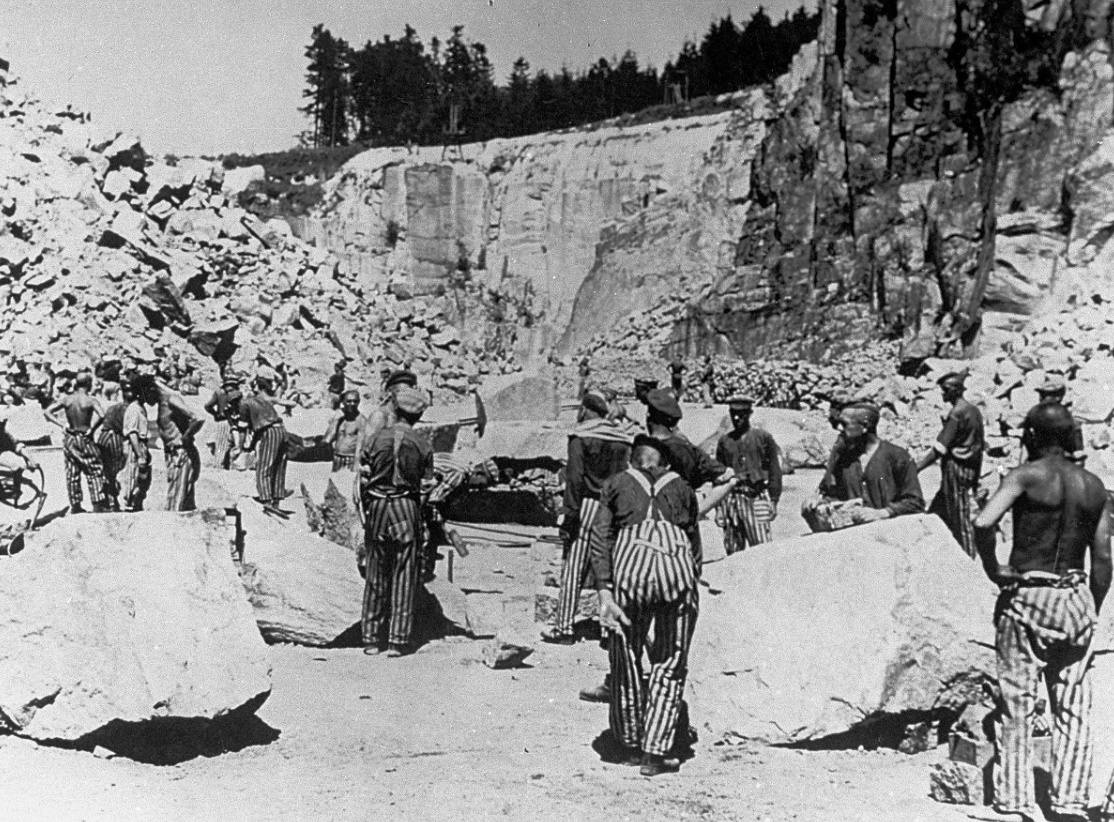The Mauthausen concentration camp
Prisoners at the construction of the "Appellplatz", 1941/42
(photo credits: Museu d'Història de Catalunya)
On 8 August 1938, five months after the annexation of Austria to the German Reich ("Anschluss"), the first inmates of the Dachau concentration camp arrived at Mauthausen. As with the construction of the Gusen annex camp in 1940, the presence of granite quarries was a decisive factor in the choice of location. The inmates were initially assigned to the construction of the camp, then to the production of building materials for the monumental and prestigious works of National Socialist Germany on behalf of the "Deutsche Erd- und Steinwerke GmbH" company belonging to the SS.
The political function of the camp, the persecution and permanent incarceration of political and ideological opponents - real or supposed - was a priority until 1943. Mauthausen and Gusen were the only camps that were sometimes classified as "level III camps", meaning that the conditions of detention there were the harshest in the entire National Socialist concentration camp system. The mortality rate was one of the highest in any concentration camp in the German Reich. As in all concentration camps, from 1942/43, prisoners were called upon to work for the arms industry. Numerous annex camps were therefore built and the number of prisoners rose sharply. At the end of 1942, there were 14,000 prisoners in Mauthausen, Gusen and several annex camps. In March 1945, there were more than 84,000 in Mauthausen and the annex camps.
From the second half of 1944, thousands of prisoners, mainly from concentration camps in territories liberated by the Allies in the East and West, were evacuated to Mauthausen. In addition, in the spring of 1945, the annex camps to the east of Mauthausen and the forced labour camps for Hungarian Jews were closed, and prisoners were taken on death marches to Mauthausen. This led to overcrowding in the camps at Mauthausen, Gusen and the remaining annex camps - Ebensee, Steyr and Gunskirchen. Hunger and disease led to a sharp rise in the mortality rate.
The majority of deportees from Mauthausen were Poles, followed by Soviet citizens and Hungarians. Groups of Germans and Austrians, French, Italians, Yugoslavs and Spaniards were also detained at Mauthausen. In total, the SS camp administration registered men, women and children from over 40 nations. Jewish prisoners from Hungary and Poland were incarcerated en masse from May 1944. Their chances of survival were the lowest.
In total, between the construction of the camp in August 1938 and its liberation by the American army in May 1945, almost 190,000 people were deported to Mauthausen. Thousands of prisoners were shot, injected or exposed to freezing temperatures. At least 10,200 prisoners were killed in the gas chambers of the main camp, the Gusen camp, the Schloss Hartheim euthanasia institute or gassed in a specially equipped vehicle that travelled between Mauthausen and Gusen. Most of the prisoners died as a result of merciless labour exploitation, ill-treatment, malnutrition, lack of clothing and lack of medical care. In total, at least 90,000 prisoners died in Mauthausen, Gusen and the annex camps, half of them in the last four months before liberation. [1]
[1] source : https://www.mauthausen-memorial.org/fr
Slave labour of prisoners in a quarry
Source: KZ-Gedenkstätte Mauthausen Bundesministerium für Inneres, Abt. IV/7
The annex camps
The labour shortage in the German Reich and the simultaneous intensification of armaments production meant that an ever-increasing number of prisoners had to be employed in the war industry. The first annex camps in 1941 still served the purposes of the SS, but from the construction of Steyr-Münichholz for Steyr-Daimler-Puch AG in1942, around 40 annex camps were created to meet the needs of the armaments industry.
In March 1945, 65,000 of the more than 84,000 prisoners held in the Mauthausen concentration camp system were in the annex camps. The prisoners were obliged to perform forced labour with construction companies to set up production sites or directly for production, mainly on behalf of Steyr-Daimler-Puch AG, the Hermann Göring Reichswerke and companies building aircraft (Heinkel-Werke and Messerschmitt).
From the end of 1943, prisoners were mainly assigned to building underground production sites, sheltered from air attacks. To this end, the Gusen camp and other camps were enlarged, and the Ebensee and Melk annex camps were built. The construction of these underground sites was undertaken with no regard for the health and lives of the prisoners and resulted in a particularly high number of victims.
In the second half of the war, the main camp at Mauthausen acted as an administrative centre, with prisoners being distributed to the annex camps. During the same period, prisoners who were ill or unfit for work were sent back from the annex camps to Mauthausen to die. Exhibitions can now be visited at the Gusen, Ebensee, Melk and Steyr annex camps.
The memorial
Although a relatively large part of the concentration camp's original building heritage has been preserved at Mauthausen, the memorial's current appearance differs significantly from the camp liberated on 5 May 1945. The camp was first administered by the American army and then, from the summer of 1945, used for several months by the Soviet army to house soldiers. On 20 June 1947, the Soviet occupation force handed over the former Mauthausen concentration camp to the Republic of Austria with the obligation to build a memorial. During the transformation into a memorial, most of the prisoners' barracks, the remaining SS barracks and the quarry facilities were dismantled. In spring 1949, the memorial known as the "Mauthausen Public Monument" ("Öffentliches Denkmal Mauthausen") was inaugurated.
In autumn 1949, France unveiled the first national monument in the area of the former SS administration barracks. Many other nations and victims' groups subsequently created other monuments.
In the early 1960s, a cemetery was set up inside the Mauthausen concentration camp memorial, where the remains of the camp's victims were later transferred from the "American cemeteries" at Mauthausen and Gusen and from mass graves dug by the SS. More than 14,000 victims were buried in part of camp II and in the barracks area of inmates 16 to 19.
The former "infirmary" ("Reviergebäude") has been used as a museum since 1970, when it was adapted for this purpose. Since May 2013, it has housed the two permanent exhibitions "The Mauthausen concentration camp 1938-1945" and "The Mauthausen crime scene - a fingerprint trail". The recently-created Espace des Noms contains the 81,000 names of those identified as having died in the Mauthausen concentration camp and its annex camps.
Memorial Mauthausen
source: https://www.mauthausen-memorial.org/pl



